Research Review on Power Quality Improvement in Distribution Networks via Charging Pile Integration
Abstract
1. Introduction
2. Impact of Charging Piles on Distribution Systems
2.1. Types of Charging Piles
2.2. Power Module of Charging Pile
2.3. Scale of Charging Stations
2.4. Penetration Rate of Electric Vehicles
3. Harmonic Mitigation Strategies
3.1. Harmonic Mitigation of Distribution Feeder Bus
3.2. Harmonic Mitigation Strategies of the Background
4. Voltage Regulation Strategies
5. Prospects of Large-Scale Charging Piles in Power Quality Management
- Leveraging the inherent compatibility between the front-end circuitry of charging piles and power quality conditioning devices, optimized control strategies can be directly integrated to embed harmonic suppression and reactive power compensation functionalities, eliminating the need for additional hardware investment.
- Utilizing the intermittent operating characteristics of charging piles, their residual capacity can be allocated during non-charging periods to implement voltage regulation, enabling a flexible resource utilization strategy that prioritizes charging during peak demand and voltage support during idle periods.
- Charging piles are usually integrated with adjacent electrical equipment at the same PCC point, making it possible to leverage their installation location for localized management. At the same time, advanced voltage feedforward control strategies can be employed to actively suppress background harmonics originating from the upstream grid, thereby achieving broader regional power quality improvements.
- Under grid fault conditions, large-scale charging piles can switch to an emergency control mode, injecting reactive power rapidly to prevent voltage collapse. Simultaneously, they can coordinate with higher-level power quality conditioning devices, forming a two-tier defense system comprising both local and regional mitigation strategies.
- With the deep integration of virtual synchronous machine technology, distributed predictive control algorithms, and power IoT, charging pile clusters will surpass the regulatory limitations of individual units, playing a pivotal role in power quality management within distribution networks.
6. Conclusions
- Investigates the various scenarios in which charging stations affect the distribution network, including both steady-state and transient power quality issues;
- Explores the current status of charging stations participating in power quality governance from a device perspective, highlighting their role in mitigating harmonics, voltage fluctuations, and other power quality disturbances.
Author Contributions
Funding
Institutional Review Board Statement
Informed Consent Statement
Data Availability Statement
Conflicts of Interest
References
- Shu, Y.B.; Tang, Y.; Zhang, L.Z.; Zhang, F.Y.; Yang, L.; Zhong, W.Z.; Gu, Z.Y. Construction of New Distribution Network and Its Key Technologies. Proc. CSEE 2024, 44, 6721–6733. [Google Scholar]
- Dong, X.Z.; Hua, Z.H.; SHang, L.; Wang, B.; Chen, L.K.; Zhang, Q.P.; Huang, Y.C. Morphological Characteristics and Technology Prospect of New Distribution System. High Volt. Eng. 2021, 47, 3021–3035. [Google Scholar]
- Wu, H.; Xu, Z.; Wang, M.; Jia, Y. Full-Model-Free Adaptive Graph Deep Deterministic Policy Gradient Model for Multi-Terminal Soft Open Point Voltage Control in Distribution Systems. J. Mod. Power Syst. Clean Energy 2024, 12, 1893–1904. [Google Scholar] [CrossRef]
- Wang, Z.; Li, X.; Sun, F. Development Trends of New Energy Vehicle Technology Under Industrial Integration. Trans. Beijing Inst. Technol. 2020, 40, 1–10. [Google Scholar]
- Pal, A.; Bhattacharya, A.; Chakraborty, A. Planning of EV Charging Station with Distribution Network Expansion Considering Traffic Congestion and Uncertainties. IEEE Trans. Ind. Appl. 2023, 59, 3810–3825. [Google Scholar] [CrossRef]
- Shaheen, A.; Ellien, A.; El-Ela, A. Optimal Integration of EV Charging Infrastructure in Sustainable Distribution Systems via Growth Optimizer-based Hong Point Estimate. Energy 2025, 318, 134567. [Google Scholar] [CrossRef]
- El-Ela, A.; Shaheen, A.; Ali, E. Allocation of EV Charging Stations in Distribution Systems using A Multi-Objective Coyote Optimizer. In Proceedings of the 2023 24th International Middle East Power System Conference (MEPCON), Mansoura, Egypt, 19–21 December 2023; pp. 1–6. [Google Scholar]
- Esmaili, A.; Oshanreh, M.M.; Naderian, S.; MacKenzie, D.; Chen, C. Assessing the spatial distributions of public electric vehicle charging stations with emphasis on equity considerations in King County, Washington. Sustain. Cities Soc. 2024, 107, 105409. [Google Scholar] [CrossRef]
- Chen, X.; Zhang, Y.J.; Huang, X.M. Review of Reactive Power and Voltage Control Method in the Background of Active Distribution Network. Autom. Electr. Power Syst. 2016, 40, 9. [Google Scholar]
- Chandra, I.; Singh, N.; Samuel, P.; Bajaj, M.; Singh, A.R.; Zaitsev, I. Optimal scheduling of solar powered EV charging stations in a radial distribution system using opposition-based competitive swarm optimization. Sci. Rep. 2025, 15, 4880. [Google Scholar] [CrossRef]
- Senol, M.; Naderi, Y.; Galloway, S. Electric Vehicles Under Low Temperatures: A Review on Battery Performance, Charging Needs, and Power Grid Impacts. IEEE Access 2023, 11, 39879–39912. [Google Scholar] [CrossRef]
- Huang, M.; Huang, S. A Harmonic Engineering Calculation Method for Electric Vehicle Charging Station. Power Syst. Technol. 2008, 32, 20–23. [Google Scholar]
- Gray, M.; Morsi, W. Power Quality Assessment in Distribution Systems Embedded with Plug-In Hybrid and Battery Electric Vehicles. IEEE Trans. Power Syst. 2015, 30, 663–671. [Google Scholar]
- Tu, H.; Feng, H.; Srdic, S.; Lukic, S. Extreme Fast Charging of Electric Vehicles: A Technology Overview. IEEE Trans. Transp. Electrif. 2019, 5, 861–878. [Google Scholar]
- Gu, Q.; Zhu, Y.; Zeng, H.; Zeng, D.; Guo, Y. Research on the Influence of Electric Vehicle Charging Station on Power Quality of Distribution Network. In Proceedings of the 2021 IEEE International Conference on Electrical Engineering and Mechatronics Technology (ICEEMT), Qingdao, China, 2–4 July 2021; pp. 286–293. [Google Scholar]
- Upputuri, R.; Subudhi, B. A Comprehensive Review and Performance Evaluation of Bidirectional Charger Topologies for V2G/G2V Operations in EV Applications. IEEE Trans. Transp. Electrif. 2024, 10, 583–595. [Google Scholar]
- Ahmad, F.; Iqbal, A.; Ashraf, I. Optimal location of electric vehicle charging station and its impact on distribution network: A review. Energy Rep. 2022, 8, 2314–2333. [Google Scholar] [CrossRef]
- Zhou, J.; Ren, G.; Wei, C.; Fan, C.; Mao, H. Harmonic analysis of electric vehicle AC charging spot and research on harmonic restriction. Power Syst. Prot. Control 2017, 45, 18–25. [Google Scholar]
- Zhang, Q.; Han, W.; Yu, J.; Li, C.; Shi, L. Simulation Model of Electric Vehicle Charging Station and the Harmonic Analysis on Power Grid. Trans. China Electrotech. Soc. 2012, 27, 159–164. [Google Scholar]
- Moses, P.S.; Masoum, M.A.S.; Smedley, K.M. Harmonic Losses and Stresses of Nonlinear Three-Phase Distribution Transformers Serving Plug-In Electric Vehicle Charging Stations. In Proceedings of the ISGT 2011, Anaheim, CA, USA, 17–19 January 2011; pp. 1–6. [Google Scholar]
- Meng, S.; Qian, K.; Wang, H.; Yuan, J.; Zhou, H.; Shi, X. Impact of EV Charging Strategies on Ampacity and Thermal Life of Distribution Cables with Consideration of Harmonic Distortions. High Volt. Eng. 2020, 46, 1269–1280. [Google Scholar]
- Xu, D.; Wang, F.; Ruan, Y. Passive Damping of LCL, LLCL and LLCCL Filters. Proc. CSEE 2015, 35, 4725–4735. [Google Scholar]
- Hu, G.; Yu, F.; Wang, W. Energy-saving technology of dynamic reactive power compensation based on STATCOM and fixed capacitor for HV induction motor. Electr. Power Autom. Equip. 2011, 31, 75–78. [Google Scholar]
- Liu, W.; Lv, Z.; Liu, H. An Overview of Morphological Development and Operation Control Technology of Power Electronics Dominated Distribution Area. Proc. CSEE 2023, 43, 4899–4922. [Google Scholar]
- Zhang, Y.; Lu, J.; Li, B. New Electric Vehicle AC Charge Spots Using Active Power Filter. High Volt. Eng. 2011, 37, 150–156. [Google Scholar]
- Choi, W.H.; Lam, C.S.; Wong, M.C.; Han, Y.D. Analysis of DC-Link Voltage Controls in Three-Phase Four-Wire Hybrid Active Power Filters. IEEE Trans. Power Electron. 2013, 28, 2180–2191. [Google Scholar]
- Zhang, J.; Wang, G. Research on the Resonance Suppression Method of the Multiple Grid-Connected Inverter Parallel System Based on Impedance Remodeling. Power Syst. Clean Energy 2023, 39, 1–7. [Google Scholar]
- Tu, C.; Li, H.; Tang, J. Development of D-STATCOM Based on Direct Current Controller. High Volt. Eng. 2008, 34, 1173–1178. [Google Scholar]
- Cai, A.; Yu, Y.; Xu, L. Review on Reactive Power Compensation of Electric Vehicle Charging Piles. In Proceedings of the 2019 22nd International Conference on Electrical Machines and Systems (ICEMS), Harbin, China, 11–14 August 2019. [Google Scholar]
- Ceng, Z.; Zhao, R.; Tang, S.; Yang, H.; Lv, Z. An Overview on Advanced Grid-connected Inverters Used for Decentralized Renewable Energy Resources. Proc. CSEE 2013, 33, 1–12+21. [Google Scholar]
- Mousavi Gazafrudi, S.; Tabakhpour Langerudy, A.; Fuchs, E.; Al-Haddad, K. Power Quality Issues in Railway Electrification: A Comprehensive Perspective. IEEE Trans. Ind. Electron. 2015, 62, 3081–3090. [Google Scholar]
- Falahi, M.; Chou, H.; Ehsani, M.; Xie, L.; Butler-Purry, K. Potential Power Quality Benefits of Electric Vehicles. IEEE Trans. Sustain. Energy 2013, 4, 1016–1023. [Google Scholar]
- Liu, X.; Zhang, Q.; Cui, S. Review of Electric Vehicle V2G Technology. Trans. China Electrotech. Soc. 2012, 27, 121–127. [Google Scholar]
- Buja, G.; Bertoluzzo, M.; Fontana, C. Reactive Power Compensation Capabilities of V2G-Enabled Electric Vehicles. IEEE Trans. Power Electron. 2017, 32, 9447–9459. [Google Scholar] [CrossRef]
- Çelik, D.; Meral, M.E. A coordinated virtual impedance control scheme for three phase four leg inverters of electric vehicle to grid (V2G). Energy 2022, 246, 123354. [Google Scholar]
- Martinenas, S.; Knezovic, K.; Marinelli, M. Management of Power Quality Issues in Low Voltage Networks Using Electric Vehicles: Experimental Validation. IEEE Trans. Power Deliv. 2017, 32, 971–979. [Google Scholar] [CrossRef]
- Suul, J.A.; D’Arco, S.; Guidi, G. Virtual Synchronous Machine-Based Control of a Single-Phase Bi-Directional Battery Charger for Providing Vehicle-to-Grid Services. IEEE Trans. Ind. Appl. 2016, 52, 3234–3244. [Google Scholar]
- Lv, Z.P.; Li, L.S.; Song, Z.H.; Yang, F.; Wang, Z.L.; Chen, Y.D. Load Virtual Synchronous Machine and Frequency Adaptive Control Applied to Electric Vehicle Charging Piles. J. Power Supply 2024, 1–16. [Google Scholar]
- Yang, C.S.; Wang, P.; Xu, D.Z. Collaborative control of DC charging piles based on flexible virtual inertia control. Electr. Power Autom. Equip. 2023, 43, 95–102. [Google Scholar]
- Jain, V.; Kewat, S.; Singh, B. Three Phase Grid Connected PV Based EV Charging Station with Capability of Compensation of Reactive Power. IEEE Trans. Ind. Appl. 2023, 59, 367–376. [Google Scholar] [CrossRef]
- Lenka, R.K.; Panda, A.K.; Patel, R.; Guerrero, J.M. PV Integrated Multifunctional Off-Board EV Charger with Improved Grid Power Quality. IEEE Trans. Ind. Appl. 2022, 58, 5520–5532. [Google Scholar]
- Shukl, P.; Singh, B. Distributed Energy Resources Based EV Charging Station with Seamless Connection to Grid. IEEE Trans. Ind. Appl. 2023, 59, 3826–3836. [Google Scholar]
- Nareshkumar, K.; Das, D. Optimal location and sizing of electric vehicles charging stations and renewable sources in a coupled transportation-power distribution network. Renew. Sustain. Energy Rev. 2024, 203, 114767. [Google Scholar]
- Yuvaraj, T.; Devabalaji, K.; Kumar, J. A Comprehensive Review and Analysis of the Allocation of Electric Vehicle Charging Stations in Distribution Networks. IEEE Access 2024, 12, 5404–5461. [Google Scholar]
- Aljumah, A.; Darwish, A.; Csala, D. A Review on the Allocation of Sustainable Distributed Generators with Electric Vehicle Charging Stations. Sustainability 2024, 16, 6353. [Google Scholar] [CrossRef]
- Adetunji, K.; Hofsajer, I.; Abu-Mahfouz, A. An optimization planning framework for allocating multiple distributed energy resources and electric vehicle charging stations in distribution networks. Appl. Energy 2022, 322, 119513. [Google Scholar]
- Soliman, I.; Tulsky, V.; Abd el Ghany, H. Efficient allocation of capacitors and vehicle-to-grid integration with electric vehicle charging stations in radial distribution networks. Appl. Energy 2025, 377, 124745. [Google Scholar]
- Mojdehi, M.N.; Ghosh, P. An On-Demand Compensation Function for an EV as a Reactive Power Service Provider. IEEE Trans. Veh. Technol. 2016, 65, 4572–4583. [Google Scholar]
- Tang, Z. The Influence of Decentralized Charging Pile Connection on Voltage Deviation of Distribution Network. J. Phys. Conf. Ser. 2023, 2592, 012095. [Google Scholar]
- Yilmaz, M.; Krein, P. Review of Battery Charger Topologies, Charging Power Levels, and Infrastructure for Plug-In Electric and Hybrid Vehicles. IEEE Trans. Power Electron. 2013, 28, 2151–2169. [Google Scholar]
- Venugopal, R.; Chandrasekar, B.; Savio, A.; Narayanamoorthi, R.; Aboras, K.; Kotb, H.; Ghadi, Y.; Shouran, M.; Elgamli, E. Review on Unidirectional Non-Isolated High Gain DC–DC Converters for EV Sustainable DC Fast Charging Applications. IEEE Access 2023, 11, 78299–78338. [Google Scholar]
- Mishra, D.; Singh, B.; Panigrahi, B. Bi-Directional EV Charging with Robust Power Controlled Adaptive Phase-Shift Algorithm. IEEE Trans. Veh. Technol. 2023, 72, 15491–15501. [Google Scholar]
- Sun, K.; Liu, G.; Li, S.; Xing, Q.; Chen, Z. Power quality analysis method of an electric vehicle charging station based on measured data. Power Syst. Prot. Control 2021, 49, 74–88. [Google Scholar]
- Li, H.; B, X. Impacts of Electric Vehicles Charging on Distribution Grid. Autom. Electr. Power Syst. 2011, 35, 38–43. [Google Scholar]
- Faraji, H.; Gharehpetian, G.B.; Khorsandi, A.; Hosseinian, S.H.; Mehrtash, M. Multiple Control Strategies for Distributed Battery Energy Storages in Microgrid DC Fast Charging Stations to Improve Load Voltage Variations, Mutual Power Exchange with the Grid and Islanded Mode Operation. IEEE Trans. Transp. Electrif. 2024, 10, 10388–10400. [Google Scholar]
- Shaheen, A.M.; Ellien, A.R.; El-Rifaie, A.M.; El-Ela, A.A.; Ali, E.S. Performance Assessment of Modern Distribution Networks Conjoined with Electric Vehicles in Normal and Faulty Conditions. Sci. Afr. 2025, 28, e02630. [Google Scholar]
- Putrus, G.A.; Suwanapingkarl, P.; Johnston, D.; Bentley, E.C.; Narayana, M. Impact of Electric Vehicles on Power Distribution Networks. In Proceedings of the 2009 IEEE Vehicle Power and Propulsion Conference, Dearborn, MI, USA, 7–10 September 2009; pp. 827–831. [Google Scholar]
- Yuan, J.; Dorn-Gomba, L.; Callegaro, A.D.; Reimers, J.; Emadi, A. A Review of Bidirectional On-Board Chargers for Electric Vehicles. IEEE Access 2021, 9, 51501–51518. [Google Scholar]
- Huang, C.; Wang, Y.; Mi, J.; Tian, X.; Zhang, S. Research on the influence of access to DC charging system of electric vehicle on grid harmonics based on active power factor correction. High Volt. Eng. 2023, 49, 239–246. [Google Scholar]
- Kazemtarghi, A.; Chandwani, A.; Ishraq, N.; Mallik, A. Active Compensation-Based Harmonic Reduction Technique to Mitigate Power Quality Impacts of EV Charging Systems. IEEE Trans. Transp. Electrif. 2023, 9, 1629–1640. [Google Scholar]
- Li, S.; Zhao, Q.; Wang, Q.; Zhou, G.; Wang, Y.; Wang, A. Plug-in Compound Feedforward Odd Harmonic Repetitive Control for Single-Phase V2G Inverters. In Proceedings of the 2024 International Conference on Advanced Mechatronic Systems (ICAMechS), Kusatsu, Japan, 26–30 November 2024; pp. 187–191. [Google Scholar]
- Zhou, L.; Shuai, Z.; Chen, Y.; Wu, W.; Zhou, X.; Yan, K.; Luo, A. Impedance-Based Harmonic Current Suppression Method for VSG Connected to Distorted Grid. IEEE Trans. Ind. Electron. 2020, 67, 5490–5502. [Google Scholar]
- Zhao, Q.; Chen, H.; Wang, Q.; Wang, Y.; Xie, W. Frequency Adaptive Feedforward Dual-Mode Repetitive Control and Proportional Control for Grid-Connected Inverters in Microgrid. Trans. China Electrotech. Soc. 2024, 39, 4843–4855. [Google Scholar]
- Srivastava, A.; Saravanan, S. Harmonic mitigation using optimal active power filter for the improvement of power quality for a electric vehicle changing station. E-Prime-Adv. Electr. Eng. Electron. Energy 2024, 8, 100527. [Google Scholar]
- Ding, X.; Shi, H.; Wang, Y.; Zhuang, Y.; Yuan, G.; Zhu, S. Research on Harmonic Management of Single-Phase AC Charging Pile Based on Active Filtering. Energies 2023, 16, 2817. [Google Scholar] [CrossRef]
- Zhou, J.; Li, J. Review of Optimal Control Technology for Three-level Power Converter System in Microgrid. High Volt. Eng. 2023, 49, 3137–3148. [Google Scholar]
- Pirouzi, S.; Aghaei, J.; Niknam, T.; Khooban, M.H.; Dragicevic, T.; Farahmand, H.; Korpås, M.; Blaabjerg, F. Power Conditioning of Distribution Networks via Single-Phase Electric Vehicles Equipped. IEEE Syst. J. 2019, 13, 3433–3442. [Google Scholar]
- Mortezaei, A.; Abdul-Hak, M.; Simões, M.G. A Bidirectional NPC-based Level 3 EV Charging System with Added Active Filter Functionality in Smart Grid Applications. In Proceedings of the 2018 IEEE Transportation Electrification Conference and Expo (ITEC), Long Beach, CA, USA, 13–15 June 2018; pp. 201–206. [Google Scholar]
- Bayhan, S.; Komurcugil, H. A T-Type converter-based Electric Vehicle Charger with Active Power Filter Functionality. In Proceedings of the IECON 2022—48th Annual Conference of the IEEE Industrial Electronics Society, Brussels, Belgium, 17–20 October 2022; pp. 1–6. [Google Scholar]
- Taghizadeh, S.; Hossain, M.J.; Poursafar, N.; Lu, J.; Konstantinou, G. A Multifunctional Single-Phase EV On-Board Charger with a New V2V Charging Assistance Capability. IEEE Access 2020, 8, 116812–116823. [Google Scholar]
- Lenka, R.K.; Panda, A.K.; Dash, A.R.; Senapati, L.; Tiwary, N. A Unified Control of Grid-Interactive Off-Board EV Battery Charger with Improved Power Quality. IEEE Trans. Transp. Electrif. 2023, 9, 920–933. [Google Scholar]
- Li, Z.; Wang, Y.; Tang, J.; Xiao, X.; Wang, H. Harmonic power allocation strategy in islanded microgrid based on remaining capacity and adaptive virtual harmonic impedance control of inverter. Power Syst. Technol. 2023, 47, 1169–1185. [Google Scholar]
- Li, Z.; Tang, X.; He, Y.; Liu, P.; Li, X. Admittance reshaping method of converter for suppressing background harmonic of grid. Proc. CSEE 2024, 44, 704–714. [Google Scholar]
- Zhang, M.; Yuan, Y.; Sun, X.; Zhang, Y.; Li, X. Harmonic Resonance Suppression Strategy of the Front-End Vienna Rectifier in EV Charging Piles. IEEE Trans. Power Electron. 2023, 38, 1036–1053. [Google Scholar]
- Xu, J.; Cao, X.; Hao, Z.; Yang, Q. A Harmonic-Current Suppression Method for Virtual Synchronous Rectifier Based on Feedforward of Grid Harmonic Voltage. Trans. China Electrotech. Soc. 2022, 37, 2018–2029. [Google Scholar]
- Song, T.; Wang, P.; Zhang, Y.; Gao, F.; Tang, Y.; Pholboon, S. Suppression Method of Current Harmonic for Three-Phase PWM Rectifier in EV Charging System. IEEE Trans. Veh. Technol. 2020, 69, 9634–9642. [Google Scholar]
- Chen, L.; Xu, Y.; Wang, T.; Chen, Z.; Sun, S. Resonance suppression method for multiple grid-connected inverters with impedance remodeling with background harmonics in a weak power grid. Power Syst. Prot. Control 2024, 52, 59–72. [Google Scholar]
- Verma, A.; Singh, B. AFF-SOGI-DRC Control of Renewable Energy Based Grid Interactive Charging Station for EV with Power Quality Improvement. IEEE Trans. Ind. Appl. 2021, 57, 588–597. [Google Scholar]
- Verma, A.; Singh, B. Multi-objective reconfigurable three phase off-board charger for EV. In Proceedings of the 2017 IEEE Transportation Electrification Conference (ITEC-India), Pune, India, 13–15 December 2017; pp. 1–6. [Google Scholar]
- Yong, J.Y.; Ramachandaramurthy, V.K.; Tan, K.M.; Selvaraj, J. Experimental Validation of a Three-Phase Off-Board Electric Vehicle Charger with New Power Grid Voltage Control. IEEE Trans. Smart Grid 2018, 9, 2703–2713. [Google Scholar]
- Tanaka, T.; Sekiya, T.; Tanaka, H.; Okamoto, M.; Hiraki, E. Smart Charger for Electric Vehicles with Power-Quality Compensator on Single-Phase Three-Wire Distribution Feeders. IEEE Trans. Ind. Appl. 2013, 49, 2628–2635. [Google Scholar]
- Tanaka, H.; Tanaka, T.; Wakimoto, T.; Hiraki, E.; Okamoto, M. Reduced-Capacity Smart Charger for Electric Vehicles on Single-Phase Three-Wire Distribution Feeders with Reactive Power Control. IEEE Trans. Ind. Appl. 2015, 51, 315–324. [Google Scholar]
- Tanaka, H.; Ikeda, F.; Tanaka, T.; Yamada, H.; Okamoto, M. Novel Reactive Power Control Strategy Based on Constant DC-Capacitor Voltage Control for Reducing the Capacity of Smart Charger for Electric Vehicles on Single-Phase Three-Wire Distribution Feeders. IEEE J. Emerg. Sel. Top. Power Electron. 2016, 4, 481–488. [Google Scholar]
- Mishra, D.; Singh, B.; Panigrahi, B. Adaptive Current Control for a Bidirectional Interleaved EV Charger with Disturbance Rejection. IEEE Trans. Ind. Appl. 2021, 57, 4080–4090. [Google Scholar]
- Park, S.; Park, S.Y. Versatile Control of Unidirectional AC–DC Boost Converters for Power Quality Mitigation. IEEE Trans. Power Electron. 2015, 30, 4738–4749. [Google Scholar]
- Fasugba, M.; Krein, P. Gaining Vehicle-to-Grid Benefits with Unidirectional Electric and Plug-in Hybrid Vehicle Chargers. In Proceedings of the 2011 IEEE Vehicle Power and Propulsion Conference, Chicago, IL, USA, 6–9 September 2011; pp. 1–6. [Google Scholar]
- Pinto, D.; Arioli, V.; Hax, G.; Borges, R.; Teixeira, W. Analysis of the Impact on Power Quality during the Recharge of Electric Vehicles and Vehicle-to-Grid Functionality. In Proceedings of the 2017 IEEE PES Innovative Smart Grid Technologies Conference Europe (ISGT-Europe), Turin, Italy, 26–29 September 2017; pp. 1–6. [Google Scholar]
- Kisacikoglu, M.C.; Kesler, M.; Tolbert, L.M. Single-Phase On-Board Bidirectional PEV Charger for V2G Reactive Power Operation. IEEE Trans. Smart Grid 2015, 6, 767–775. [Google Scholar]
- Kesler, M.; Kisacikoglu, M.C.; Tolbert, L.M. Vehicle-to-Grid Reactive Power Operation Using Plug-In Electric Vehicle Bidirectional Offboard Charger. IEEE Trans. Ind. Electron. 2014, 61, 6778–6784. [Google Scholar]
- Yong, J.; Ramachandaramurthy, V.; Tan, K.; Mithulananthan, N. Bi-Directional Electric Vehicle Fast Charging Station with Novel Reactive Power Compensation for Voltage Regulation. Int. J. Electr. Power Energy Syst. 2015, 64, 300–310. [Google Scholar]
- Hu, J.; Ye, C.; Ding, Y.; Tang, J.; Liu, S. A Distributed MPC to Exploit Reactive Power V2G for Real-Time Voltage Regulation in Distribution Networks. IEEE Trans. Smart Grid 2022, 13, 576–588. [Google Scholar]
- Liu, D.; Zhong, Q.; Wang, Y.; Liang, Y. A Synchronverter-based V2G Smart Charging and Discharging Control Strategy for Electric Vehicles. Proc. CSEE 2017, 37, 544–557. [Google Scholar]
- Hao, Z.; Xu, J.; Wang, X.; Cao, X.; Yang, Q. A Control Method for Three-Phase PWM Rectifier with Function of Friendly Interaction Between Grid and Load. J. Nanjing Univ. Aeronaut. Astronaut. 2020, 52, 199–206. [Google Scholar]
- Roveri, A.; Mallemaci, V.; Mandrile, F.; Bojoi, R. Power Decoupling Methods for Grid Support Provided by Ultra-Fast Bidirectional Chargers. IEEE Open J. Ind. Appl. 2025, 6, 107–119. [Google Scholar]
- Safari, A.; Rahbarimagham, H. An Improved Control Strategy for Managing Reactive Power and Reducing Capacity of Interlinking Converters by Participating of Electric Vehicles in Hybrid AC/DC Microgrids. IEEE Access 2025, 13, 17878–17894. [Google Scholar]
- Zahedmanesh, A.; Muttaqi, K.; Sutanto, D. Coordinated Charging Control of Electric Vehicles While Improving Power Quality in Power Grids Using a Hierarchical Decision-Making Approach. IEEE Trans. Veh. Technol. 2020, 69, 12585–12596. [Google Scholar]
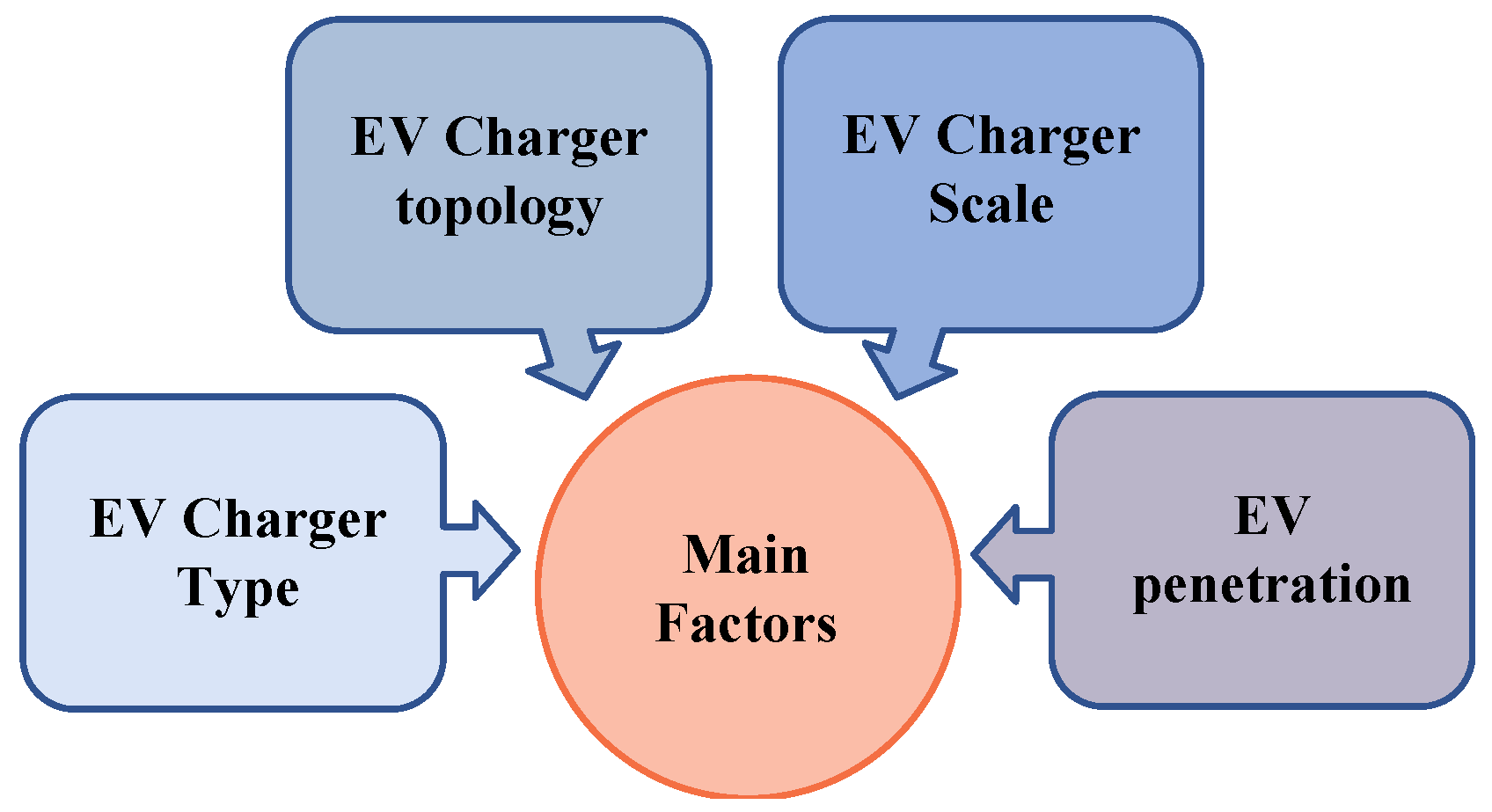
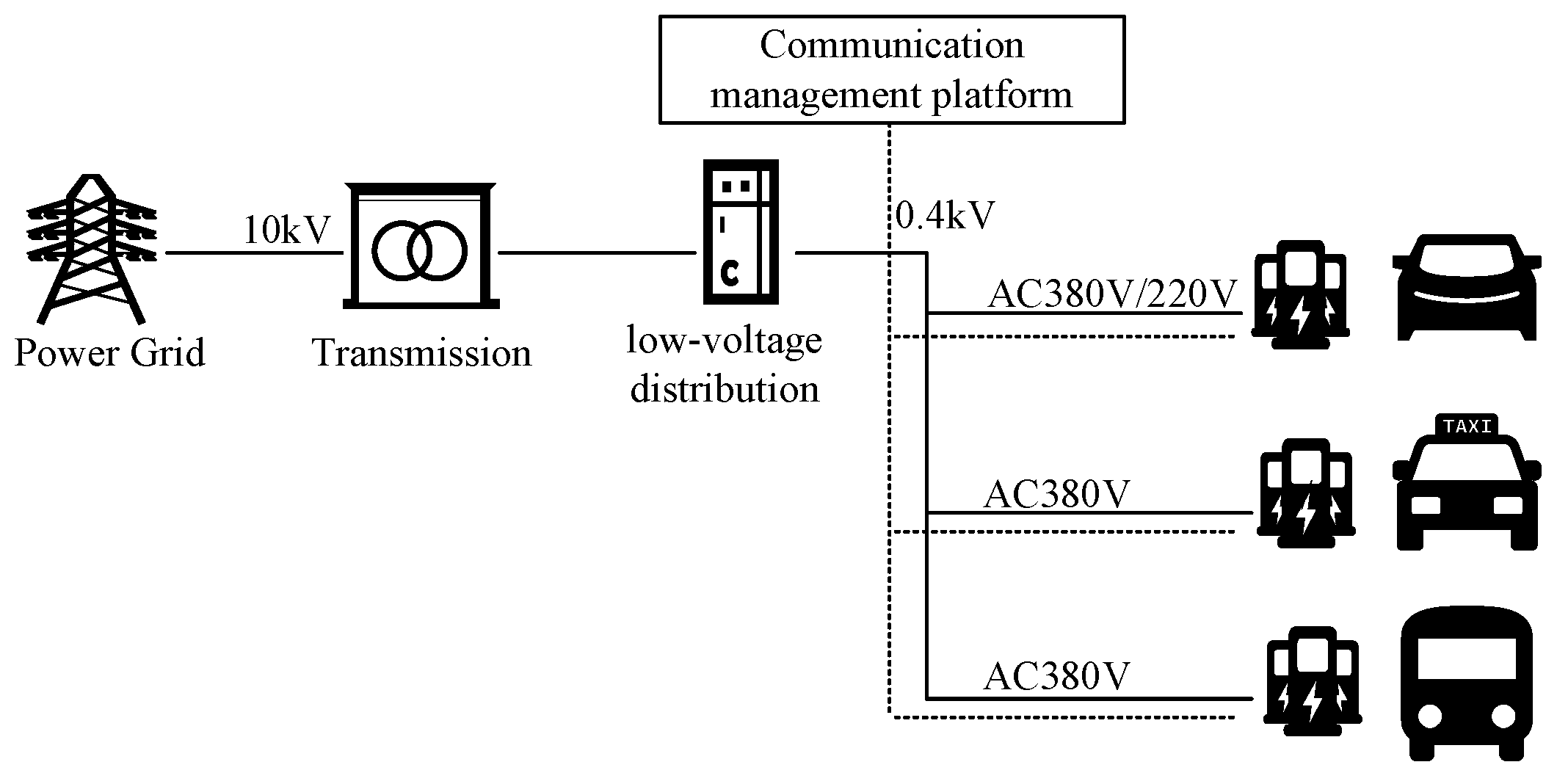
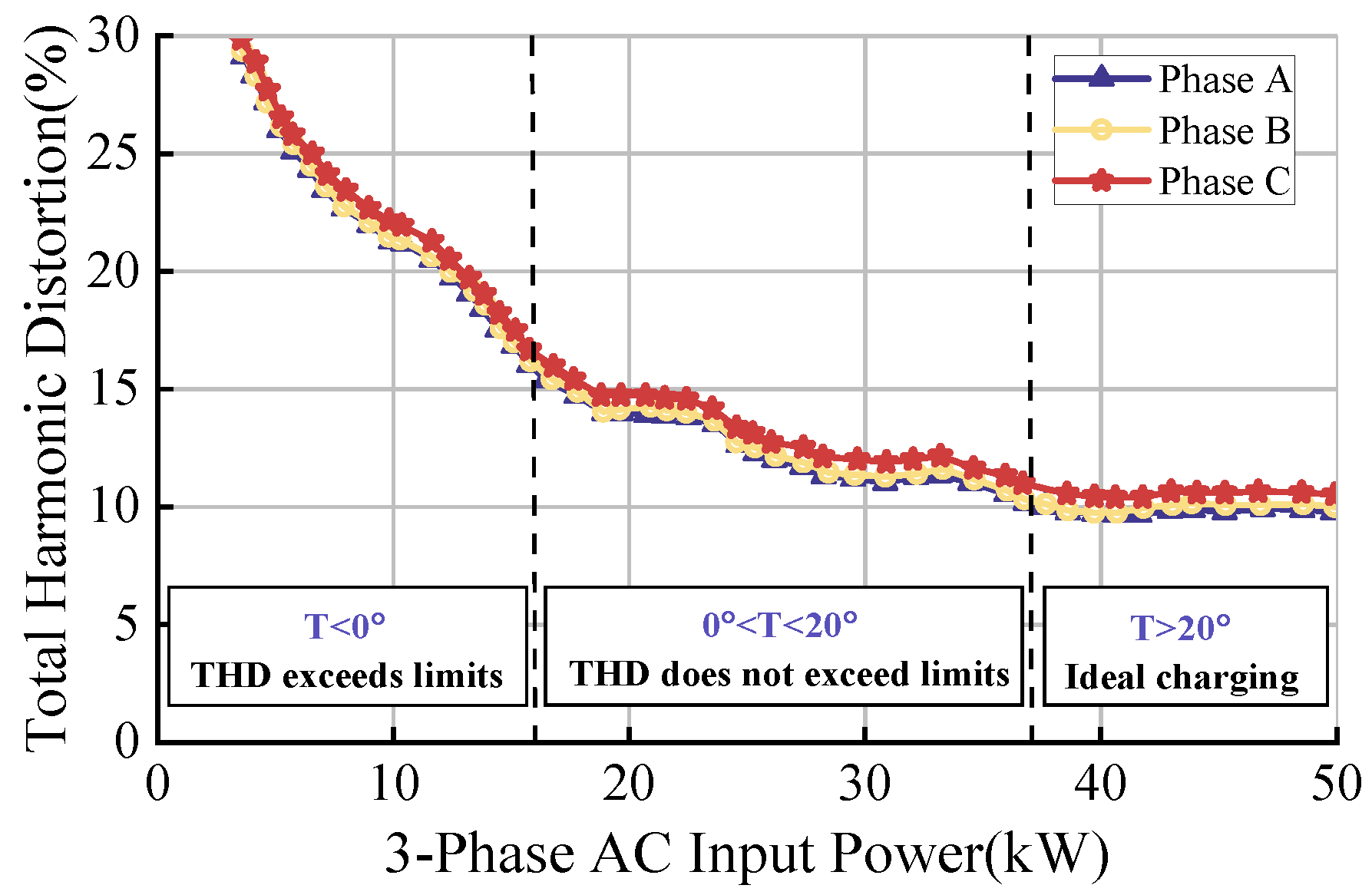

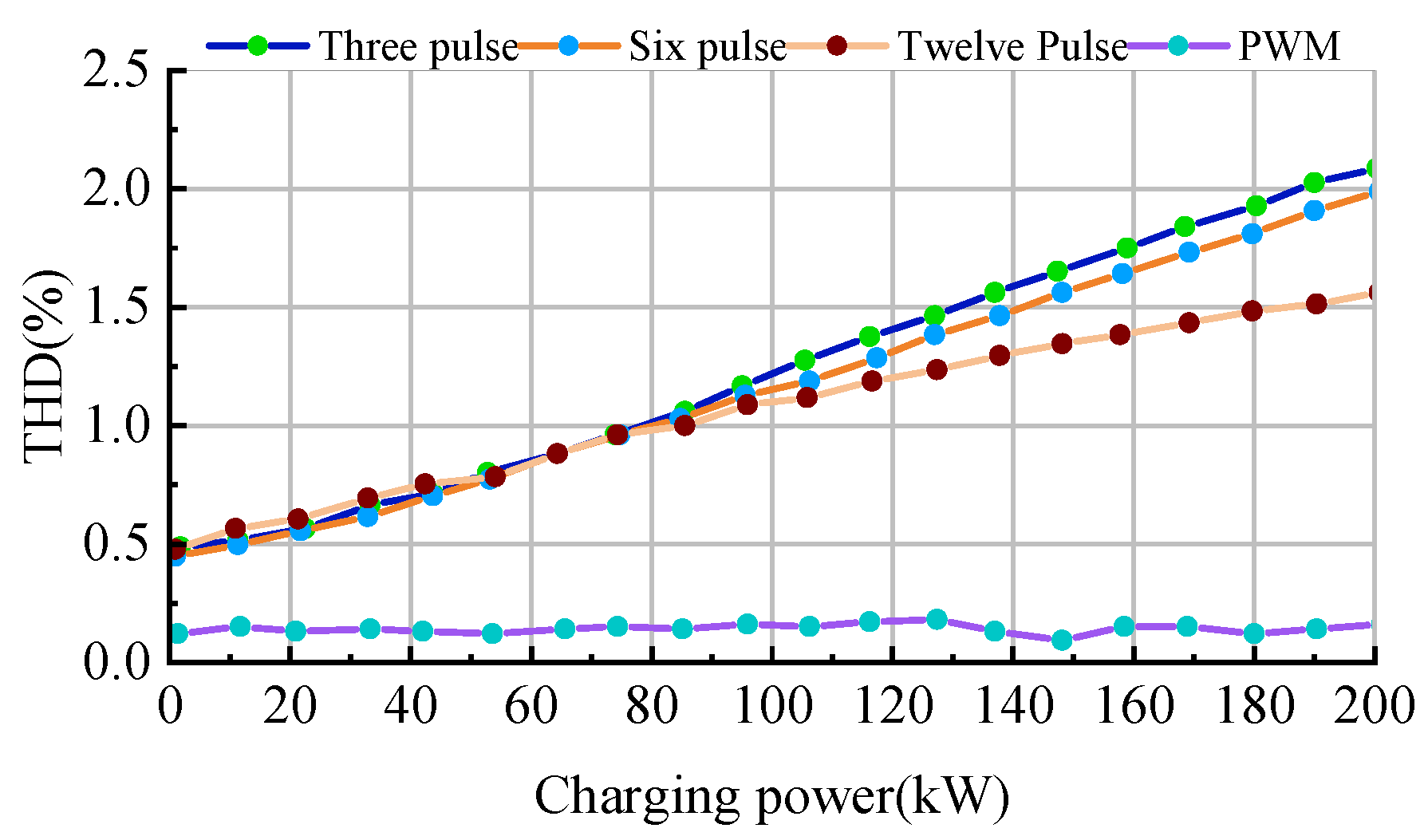
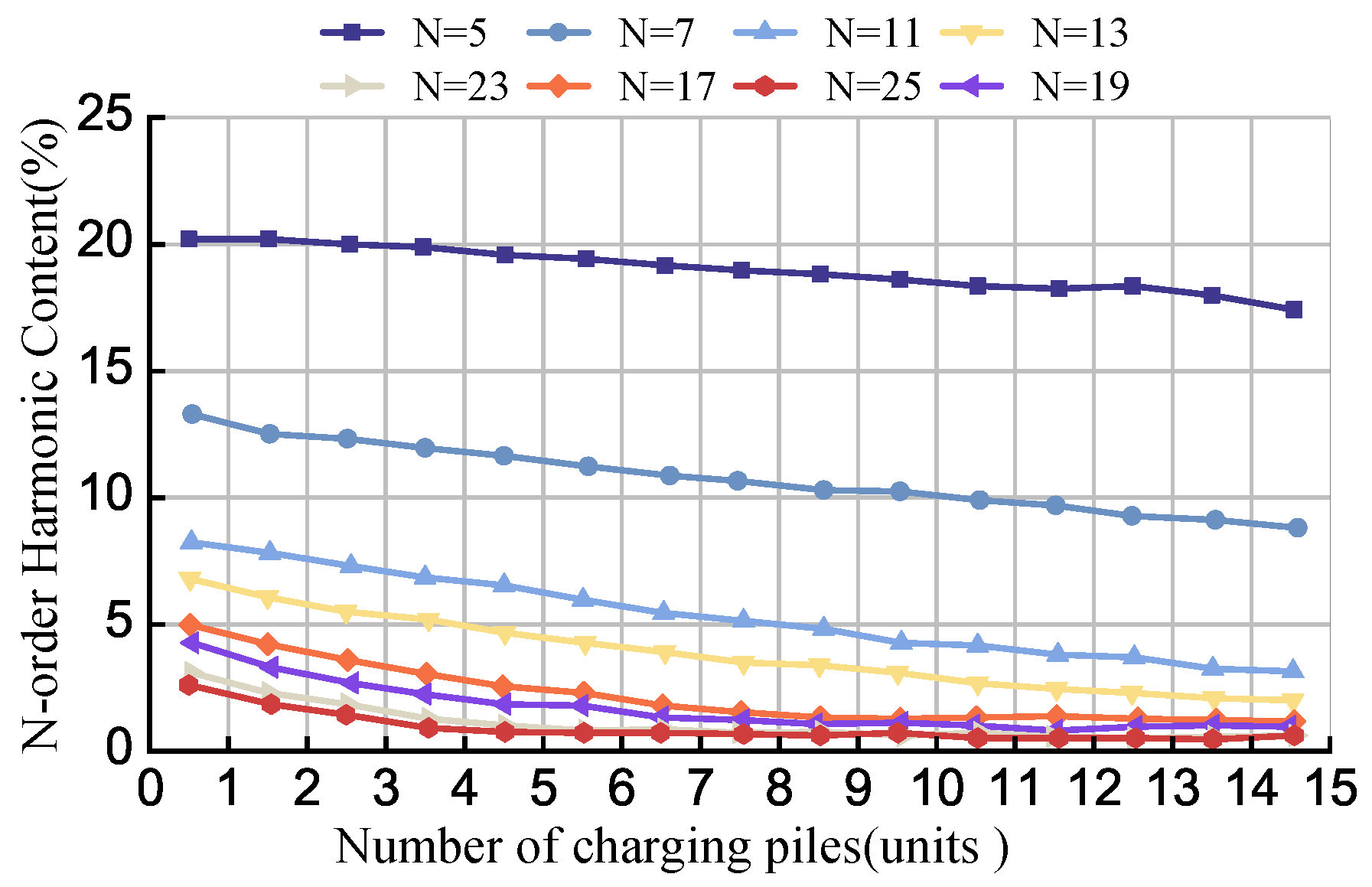

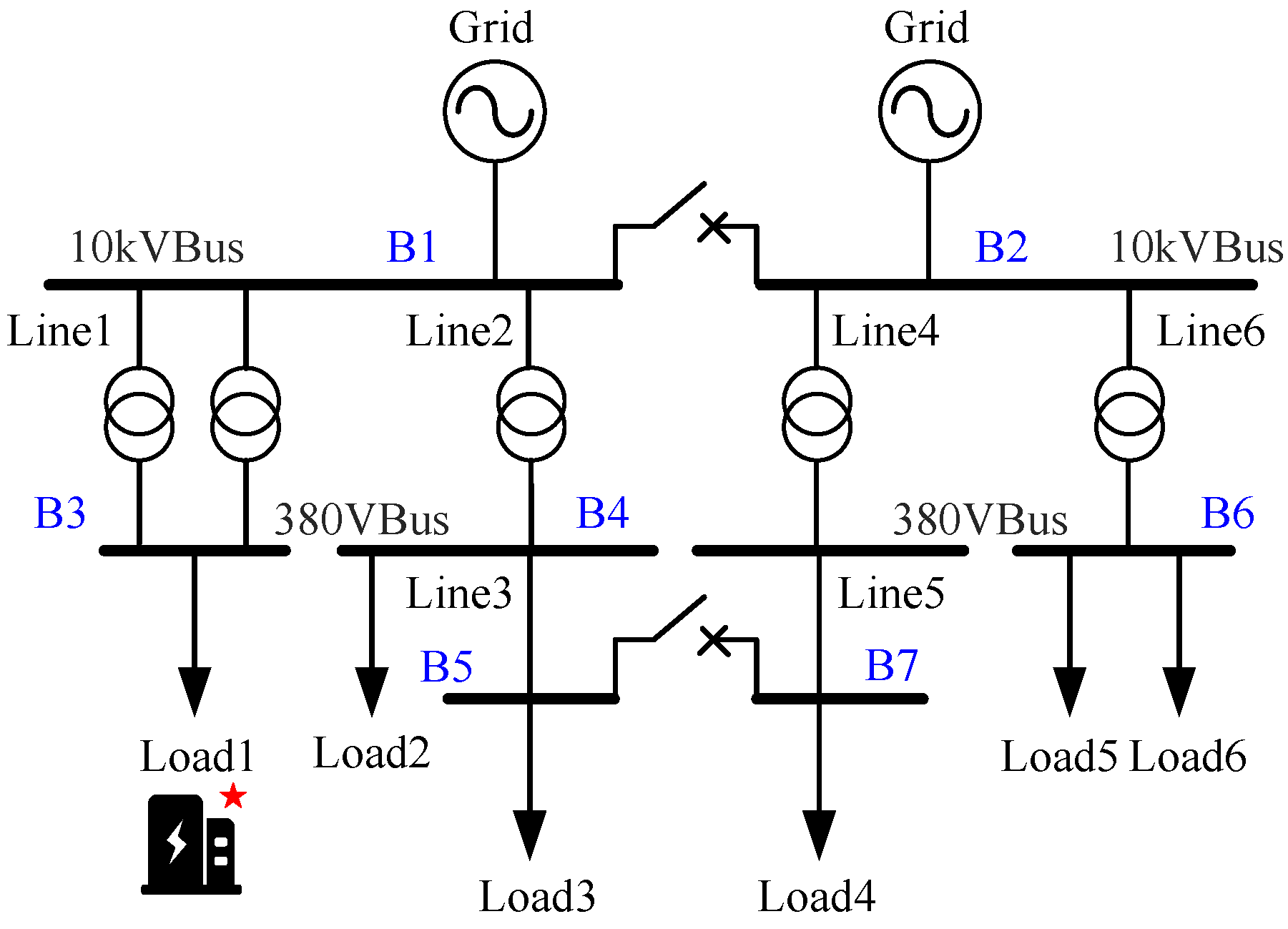
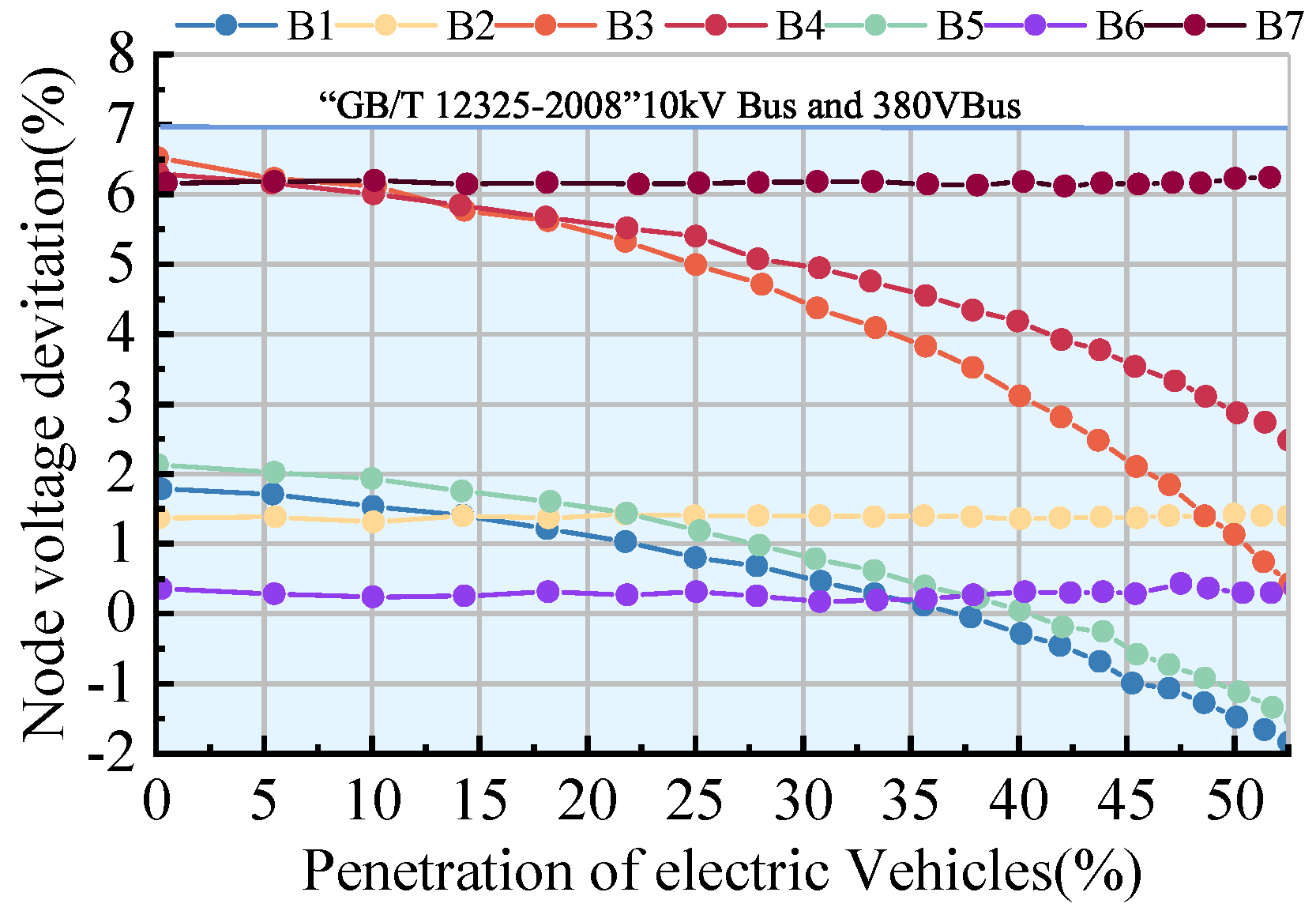


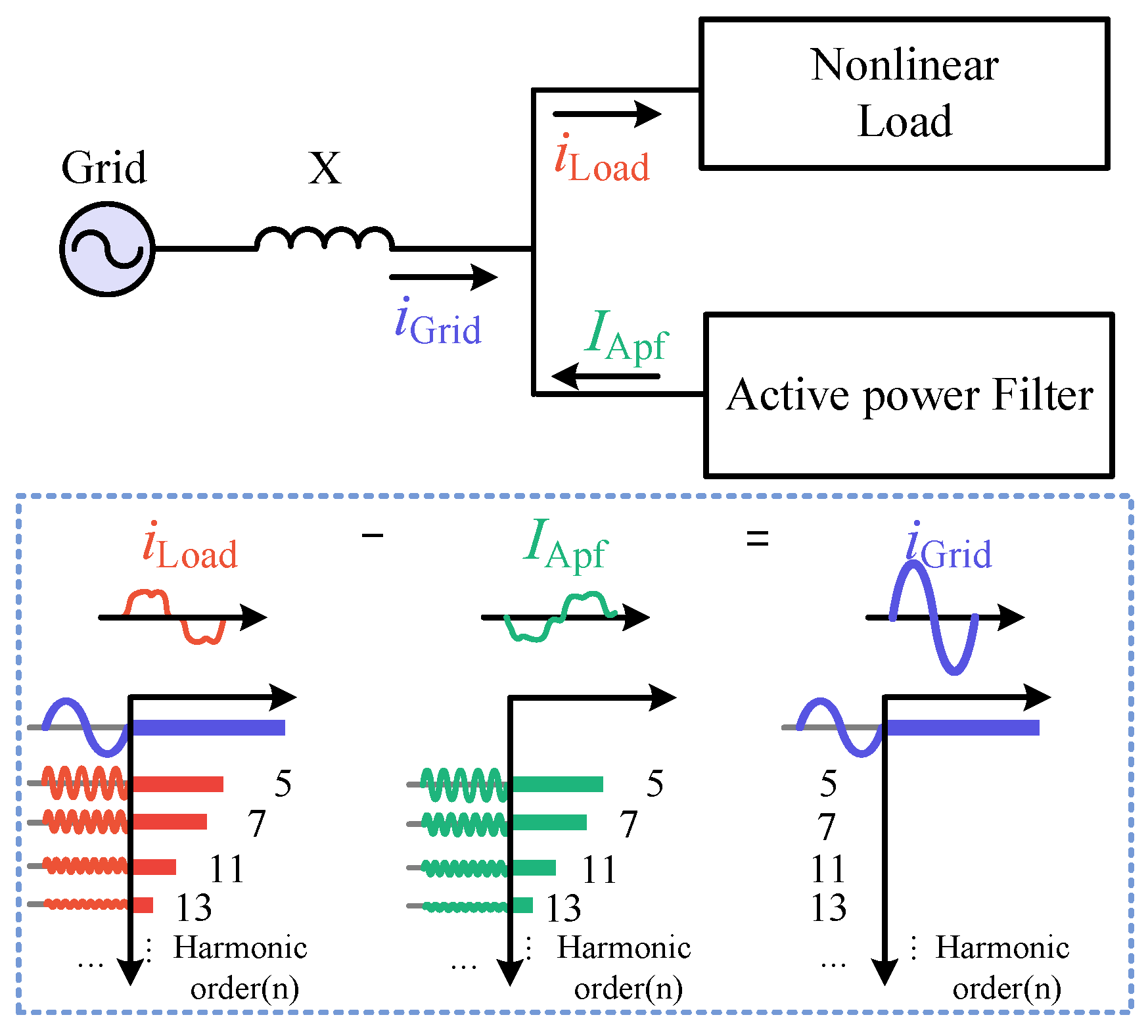
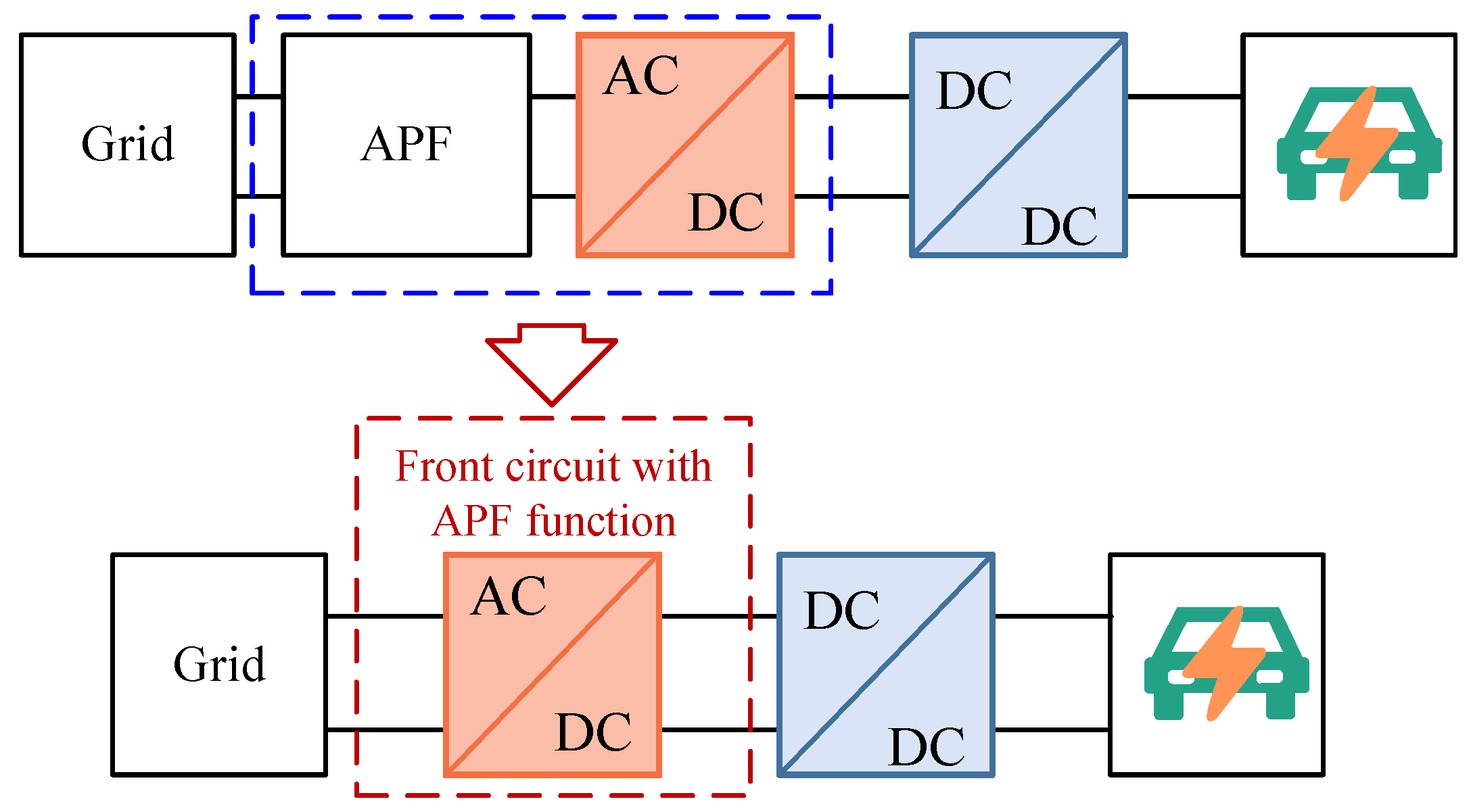
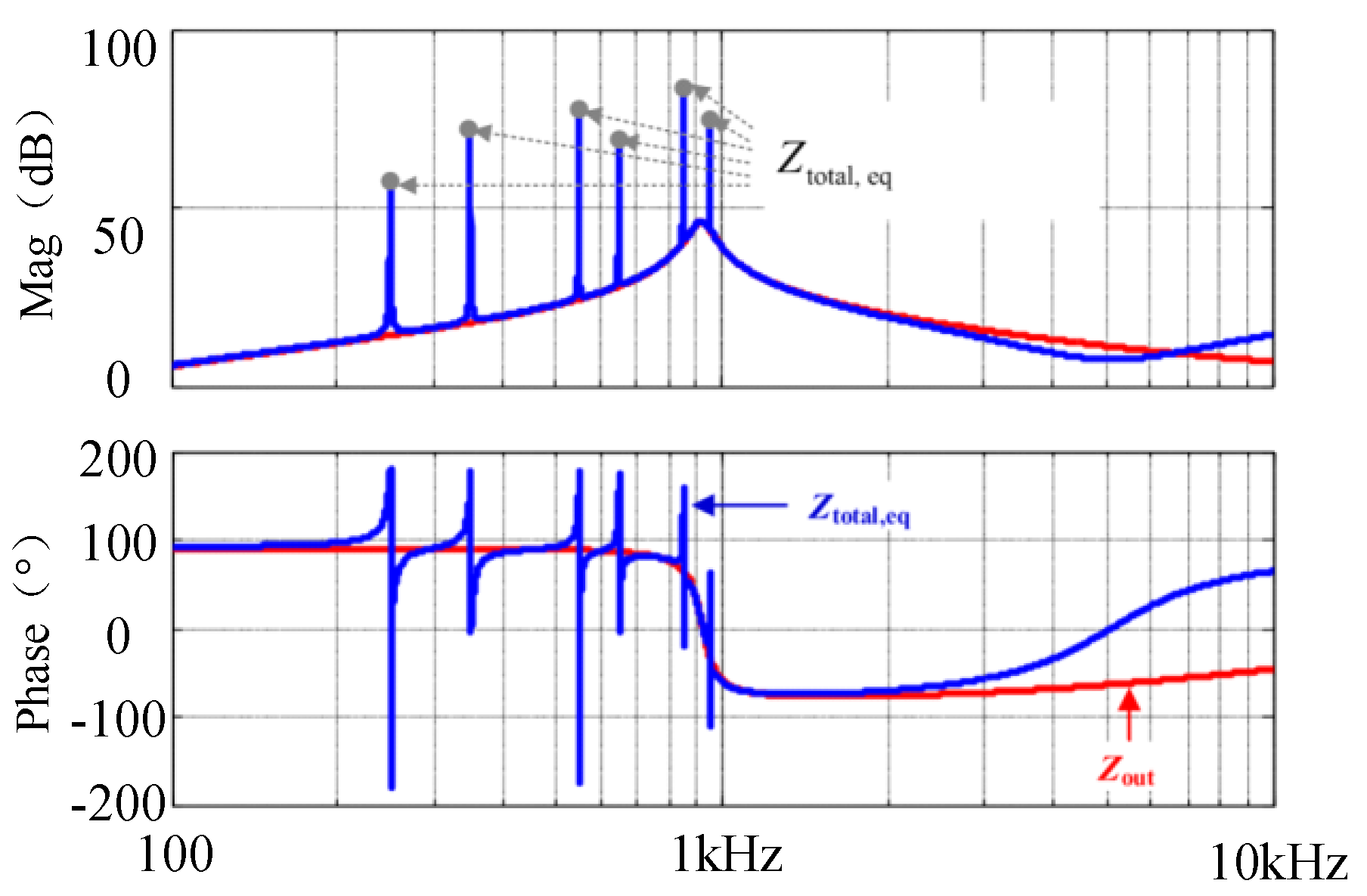


| Level 1 (Slow) | Level 2 (Semi-Fast) | Level 3 (Fast) | |
|---|---|---|---|
| Voltage Level (V) | 120 (AC) | 208–240 (AC) | 50–1000 (DC) |
| Max Power (kW) | 1.44 or 1.92 | 5 or 19.2 | 80–400 |
| Charging time (h) | 4–12 | 2–6 | 0.2–1.0 |
| Phase | 1 phase | 1 or 3 phase | 3 phase |
| Charger location | On-board | On-board | Off-board |
| Installation | Domestic | Domestic/Commercial | Commercial |
| Charging Period | Penetration Level | 0% | 10% | 20% | 30% |
|---|---|---|---|---|---|
| 21:00–6:00 | Summer Winter | 3.1 4.2 | 3.5 4.4 | 4.4 4.9 | 5.0 5.5 |
| 18:00–21:00 | Summer Winter | 3.0 4.8 | 4.4 6.3 | 6.5 8.5 | 8.1 10.3 |
| 10:00–16:00 | Summer Winter | 3.0 3.7 | 4.1 4.9 | 5.6 6.4 | 6.9 7.7 |
| Reference | Method | Techniques | Harmonic Supression | Harmonic Compensation | Voltage Compensation |
|---|---|---|---|---|---|
| [18,25,26,27,64,65] | active | SAPF | ✓ | ||
| [22] | passive | LCl/LC filter | ✓ | ||
| [35,62,72] | active | Virtual impedance | ✓ | ✓ | ✓ |
| [40] | active | Power control | ✓ | ✓ | ✓ |
| [22,41,70,71] | active | Adaptive filter | ✓ | ✓ | ✓ |
| [52,59,60,61,63,84] | active | SMC/PFC/ACHR/ | ✓ | ||
| Resonant controller | |||||
| [67] | active | Resonant controller | ✓ | ✓ | ✓ |
| [68,69] | active | Serves as an APF | ✓ | ||
| [73,74,75,76,77] | active | Admittance reshaping | ✓ | ||
| [78,79] | active | Advanced PLL | ✓ | ✓ | ✓ |
| Reference | Method | Techniques | Voltage Regulation | Voltage Compensation | Harmonic Supression |
|---|---|---|---|---|---|
| [23] | passive | fixed capacitors | ✓ | ✓ | |
| [28,29] | active | SVG/statcom | ✓ | ||
| [32,88,89,90] | active | power control | ✓ | ✓ | |
| [36,36] | active | DRoop control | ✓ | ✓ | |
| [37,38,92,93,94] | active | VSG | ✓ | ✓ | |
| [80,81,82,83,85] | active | PFC | ✓ |
Disclaimer/Publisher’s Note: The statements, opinions and data contained in all publications are solely those of the individual author(s) and contributor(s) and not of MDPI and/or the editor(s). MDPI and/or the editor(s) disclaim responsibility for any injury to people or property resulting from any ideas, methods, instructions or products referred to in the content. |
© 2025 by the authors. Licensee MDPI, Basel, Switzerland. This article is an open access article distributed under the terms and conditions of the Creative Commons Attribution (CC BY) license (https://creativecommons.org/licenses/by/4.0/).
Share and Cite
Chen, S.; Zhou, J.; Sun, Y. Research Review on Power Quality Improvement in Distribution Networks via Charging Pile Integration. Electronics 2025, 14, 1284. https://doi.org/10.3390/electronics14071284
Chen S, Zhou J, Sun Y. Research Review on Power Quality Improvement in Distribution Networks via Charging Pile Integration. Electronics. 2025; 14(7):1284. https://doi.org/10.3390/electronics14071284
Chicago/Turabian StyleChen, Shasha, Jinghua Zhou, and Yifei Sun. 2025. "Research Review on Power Quality Improvement in Distribution Networks via Charging Pile Integration" Electronics 14, no. 7: 1284. https://doi.org/10.3390/electronics14071284
APA StyleChen, S., Zhou, J., & Sun, Y. (2025). Research Review on Power Quality Improvement in Distribution Networks via Charging Pile Integration. Electronics, 14(7), 1284. https://doi.org/10.3390/electronics14071284




